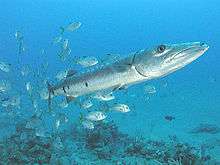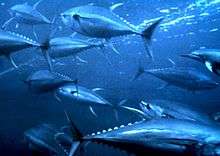Marine Conservation Institute
 | |
| Founded | 1996 |
|---|---|
| Focus | Oceans, overfishing, habitat destruction, pollution, Coral Reefs, Marine Protected Area, Ocean Acidification, High Seas |
| Location | |
Area served | Global |
| Method | Scientific Research and Policy Advocacy |
Key people |
Elliott Norse, Ph.D., Founder and Chief Scientist Lance Morgan, Ph.D., President and CEO Sylvia Earle, Ph.D., Board member |
Revenue | $1,792,140 (2011) |
| Slogan | Saving Wild Ocean Places, for Us and Future Generations |
| Website | Marine-Conservation.org |
Marine Conservation Institute (formerly Marine Conservation Biology Institute) is a tax-exempt nonprofit ocean conservation organization working to identify and protect vulnerable ocean ecosystems worldwide. The organization is headquartered in Seattle, Washington with offices in Washington D.C. and Glen Ellen, California.
Mission
Marine Conservation Institute is a nonprofit organization and a leader in the global movement to protect the world’s oceans. Working with scientists, politicians, government officials, and other organizations, Marine Conservation Institute is active around the world to protect vulnerable ocean ecosystems and the species within them.[1]
Marine Conservation Institute uses sound marine science and research to first identify the most ecologically significant ocean places and then advocates for their protection. This work involves understanding the key threats to these unique places and how the species calling the ocean home are impacted. Decades of conservation policy experience guide this ongoing work.
Marine Conservation Institute is a four-star Charity Navigator rated organization.[2]
Previous names
Marine Conservation Biology Institute, 1996-2011[3]
History
Marine Conservation Institute was founded under the name Marine Conservation Biology Institute (MCBI) in 1996 by Dr. Elliott Norse, a biologist who had previously worked at the Council on Environmental Quality and the Ocean Conservancy.[3]
MCBI’s focus was initially to bridge the gap between scientists who understand marine ecosystems and policy makers who determine their fate. In 2000 letter written to President Clinton, a request was made to establish a national system of marine protected areas (MPAs), which led to Executive Order 13158 on Marine Protected Areas. In 2004, MCBI co-founded the Deep Sea Conservation Coalition and released the Scientists’ Statement on Protecting the World’s Deep Sea Coral and Sponge Ecosystems, signed by 1,136 scientists from 69 countries.[4] (The statement was later reopened to signing, and the number of signers increased to 1,452 in 2006.[5])
In 2005, Elliott Norse was the lead editor and co-author of Marine Conservation Biology: The Science of Maintaining the Sea's Biodiversity, the first textbook focused on the science of marine conservation, published by Island Press.[6]
A consistent theme of the organization was the threat of deep-sea bottom trawling fisheries to coral habitats and other sensitive sea floors. In 2007 MCBI led a joint statement at the American Association for the Advancement of Science meeting calling for the abolition of subsidies that permit deep-sea trawling, which built on the previous scientists' statement.[7]
In January 2009, MCBI was praised for its work in the designation of three large marine national monument in the U.S. territories of the Pacific Ocean by President George W. Bush. In "Green Bush: The departing president tries to burnish his environmental halo," The Economist wrote, "much of the scientific donkey-work and lobbying behind Mr Bush's reserves was done by ... the Marine Conservation Biology Institute, in Washington. Congratulations."[8]
In 2011, MCBI shortened its name to Marine Conservation Institute.[3] A paper in Marine Policy expanded on the organization's long-term emphasis on threats posed by bottom trawling, generated substantial media attention.[9] In the Washington Post, the paper generated the headline "Scientists call for end to deep-sea fishing," citing the evidence of extensive damage to bottom habitats.[10]
In 2012 Dr. Norse resigned as President, becoming Chief Scientist, and Dr. Lance E. Morgan took the role of President.[11] On World Oceans Day in June 2012, Marine Conservation Institute announced the launch of the MPAtlas, a global searchable database of marine protected area sites funded by the Waitt Foundation, headed by Ted Waitt.[12]
In May 2013, Marine Conservation Institute and Sylvia Earle's organization Mission Blue[13] released "SeaStates.US 2013: How Well Does Your State Protect Your Coastal Waters?" a report on US states and territories and the percentage of the state marine waters that are established as a "no-take" marine reserve, in which no fishing, energy extraction, or other uses are permitted.[14] The report showed that 15 of the 23 US coastal states and territories had zero square kilometers as "no-take" reserves, and that only one state - Hawaii exceeded 20% as no-take reserves. California and the US Virgin Islands were the only other states or territories that exceeded 5%.
In October 2013, to recover the diversity and abundance of marine life, Marine Conservation Institute initiated the Global Ocean Refuge System (GLORES, pronounced glôr-ees), a strategic, science-based way to safeguard marine ecosystems on a global scale. GLORES is designed to catalyze strong protection for at least 20% of the ecosystems in each marine biogeographic region by 2030, enough to avert mass extinction.
Funding sources
Marine Conservation Institute draws funding from private foundations, individual donors, corporations, and government agencies. In 2011, according to its IRS Form 990, the organization had $1,792,140 in revenue.[15]
Programs
Marine Conservation Institute’s work falls under three broad themes, Identifying Vulnerable Marine Ecosystems, Advocating for Healthy Oceans, and Protecting Wild Places. In this way, Marine Conservation Institute bridges the gap between marine science and policy – with an aim toward achieving the oceans’ biological diversity and sustainable productivity.
Following are the current focus areas of Marine Conservation Institute.
- Marine Protected Areas (MPAs)[16]
Marine Protected Area (MPA) designations are some of the simplest of marine management tools that can offer some of the highest gains in terms of marine conservation. By limiting some uses from a marine environment, certain ecosystems can regain their actual function, populations can be bolstered and habitats protected. Currently, strictly protected MPAs cover barely more than 1 percent of the world’s oceans. Marine Conservation Institute's ambitious goal is to protect 10% of the global ocean by 2020. Currently its work encompasses science and advocacy on the United States National Marine Sanctuary system, United States Marine Marine National Monument (United States) areas, and MPAs in foreign EEZs and on the high seas.
- Coral Conservation[17]
Marine Conservation Institute works to protect coral reef ecosystems by establishing large marine protected areas that will protect tropical coral reefs. Marine Conservation Institute also works for the protection of deep sea corals by using advanced technology to predict their location and then advocate for their protection.
- Sustainable Fishing[18]
Marine Conservation Institute is encouraging fishermen to shift toward using sustainable fishing methods. Since the organization’s founding, the staff has worked to limit the impact of bottom trawling and other destructive fishing gear on sensitive marine ecosystems, while encouraging the use of fishing methods that are less harmful to benthic habitats and have lower rates of bycatch,unwanted species caught up in the net, many of which are thrown away dead or dying.
- High Seas Conservation[19]
The high seas are home to great whales, sea turtles, seabirds, tunas, and sharks that traverse entire ocean basins in search of food. High seas biodiversity is threatened by fishing, climate change and other human-caused impacts. The global community, through the United Nations Convention on Biological Diversity and the UN Food and Agriculture Organization, has developed criteria to identify ecologically important and vulnerable areas in the high seas. Marine Conservation Institute has worked with the global scientific community to provide information on high seas habitats and ecology to international authorities charged with high seas management.
- Ocean Acidification[20]
There is clear and unambiguous scientific evidence that documents how rising atmospheric carbon dioxide is leading to increasingly acidic seawater. This has been termed ocean acidification and presents a threat to marine organisms that build their structures of calcium carbonate and, by extension, the organisms that feed on and live among them. Marine Conservation Institute is working with partners from the scientific community, political arena, and coastal fishing and aquaculture industries to address the emerging threat of ocean acidification and the impacts on marine ecosystems.
- Ocean Governance[21]
We work to ensure effective ocean management and governance for our marine resources through policy and funding. We synthesize vitally important scientific and policy information and provide it to decision makers involved in the federal budget and appropriations process in order to encourage sustainable use of our ocean resources and ensure healthy oceans now and for future generations. Marine Conservation Institute works to ensure the federal government is adequately funding marine conservation efforts in the United States.
- Enforcement[22]
Several large remote marine protected areas have been established in United States’ waters in recent years, and more are likely in the near future, both within US national boundaries and on the high seas. Resolving the challenges of enforcing regulations within these areas will become more urgent as fishing depletes coastal resources and moves into deeper and more remote areas. Marine Conservation Institute is working with enforcement agencies in the southeastern US and Pacific to optimize surveillance and enforcement capacity for recently designated large marine protected areas.
Board of Directors
- Chair, David Johns
- Vice Chair, John Davis
- Treasurer, Eugene Duvernoy
- President, Lance E. Morgan, Ph.D.
- Founder, Elliott A. Norse, Ph.D.
- Sylvia Earle, Ph.D.
- Amy Mathews-Amos
- Les Watling, Ph.D.
- Gail Osherenko
See also
References
- ↑ Marine Conservation Institute. Who We Are: Mission. http://www.marine-conservation.org/who-we-are/#mission
- ↑ Marine Conservation Institute's Charity Navigator page. http://www.charitynavigator.org/index.cfm?bay=search.summary&orgid=10605
- 1 2 3 Marine Conservation Institute. Who We Are: Our History. http://www.marine-conservation.org/who-we-are/history/
- ↑ 1,136 scientists call for protection of deep-sea corals. MCBI Press Release, Feb. 15, 2004. http://www.eurekalert.org/pub_releases/2004-02/s-1sc021004.php
- ↑ Marine Conservation Institute. Deep-Sea Coral Scientist Statement. http://mcbi.marine-conservation.org/what/dscstatement.htm
- ↑ Norse, Elliott A. and Crowder, Larry B. (Eds.) (2005) Marine Conservation Biology: The Science of Maintaining the Sea's Biodiversity, Island Press. ISBN 978-1-55963-662-9
- ↑ The Last Wild Hunt: Deep-Sea Fisheries Scrape Bottom Of The Sea. Science Daily, Feb. 19, 2007. http://www.sciencedaily.com/releases/2007/02/070218130829.htm
- ↑ Green Bush: The departing president tries to burnish his environmental halo. The Economist, January 8, 2009. http://www.economist.com/node/12887199
- ↑ Norse, E. et al., 2011. Sustainability of deep-sea fisheries. Marine Policy: 36 (2012) 307–320. http://www.marine-conservation.org/media/filer_public/2011/09/06/norse_et_al_2012_sustainability_of_deep-sea_fisheries.pdf
- ↑ Scientists Call for End to Deep-Sea Fishing. Washington Post, September 6, 2011. http://www.washingtonpost.com/national/health-science/scientists-call-for-end-to-deep-sea-fishing/2011/08/30/gIQApPJc7J_story.html
- ↑ Press Release: Marine Conservation Institute gets new leader. 2012. http://www.marine-conservation.org/media/filer_public/2012/07/31/20120606_lance_morgan_named_president_and_ceo.pdf
- ↑ MPAtlas. http://www.mpatlas.org/
- ↑ Mission Blue. http://mission-blue.org/
- ↑ West Is Best: Study Ranks U.S. States for Marine Conservation Progress. Science Magazine, May 29, 2013. http://news.sciencemag.org/2013/05/west-best-study-ranks-u.s.-states-marine-conservation-progress
- ↑ Guidetar. Marine Conservation Institute Financial Report. http://www.guidestar.org/PartnerReport.aspx?Partner=foundationsource&ein=91-1725640
- ↑ Marine Conservation Institute. Program Areas: Marine Protected Areas. http://www.marine-conservation.org/what-we-do/program-areas/mpas/
- ↑ Marine Conservation Institute. Program Areas: Coral Conservation. http://www.marine-conservation.org/what-we-do/program-areas/coral-conservation/
- ↑ Marine Conservation Institute. Program Areas: How We Fish. http://www.marine-conservation.org/what-we-do/program-areas/how-we-fish/
- ↑ Marine Conservation Institute. Program Areas: High Seas Conservation. http://www.marine-conservation.org/what-we-do/program-areas/high-seas/
- ↑ Marine Conservation Institute. Program Areas: Ocean Acidification. http://www.marine-conservation.org/what-we-do/program-areas/ocean-acidification/
- ↑ Marine Conservation Institute. Program Areas: Ocean Governance. http://www.marine-conservation.org/what-we-do/program-areas/ocean-governance/
- ↑ Marine Conservation Institute. Program Areas: Enforcement. http://www.marine-conservation.org/what-we-do/program-areas/enforcement/
External links
- Marine Conservation Institute homepage
- Marine Protected Area Atlas, MPAtlas
- SeaStates.US 2013: How Well Does Your State Protect Your Coastal Waters?
- Global Ocean Refuge System homepage

